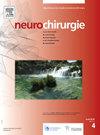Evaluation of parenchymal collaterals in patients with meningioma using contrast-enhanced T1 MPRAGE sequence
IF 1.4
4区 医学
Q4 CLINICAL NEUROLOGY
引用次数: 0
Abstract
Background
Post-contrast T1-MPRAGE sequence has been used in routine tumor imaging at many centers for decades. Meningiomas may be accompanied by leptomeningeal as well as parenchymal collaterals. In this study, we aimed to demonstrate the collaterals that may accompany meningiomas on postcontrast T1-MPRAGE imaging and to investigate their relationship with location, size, histologic features, adjacent bone, and parenchymal changes.
Methods
In this study, postcontrast T1-MPRAGE images of 326 meningiomas from 259 patients were independently analyzed by two observers. The presence of parenchymal collaterals and unilateral, contralateral or bilateral localization were determined. Meningiomas' diameters, locations, presence of dural sinus invasion, associated parenchymal changes and bony changes were determined. Histologic grades were determined if applicable. The data obtained were analyzed statistically.
Results
Parenchymal collaterals were demonstrated in 25% of meningiomas (66/259). Of these, 65% were unilateral, 12% contralateral and 23% bilateral. There was a significant correlation between malignancy and the presence of collaterals in histologically diagnosed meningiomas (77%, p = 0.01). The presence of collaterals was also significantly higher in meningiomas with sinus invasion and bone destruction (p < 0.001). As tumor size increased, unilateral and bilateral collateral development increased (p < 0.001, p = 0.008, respectively), but it was not significant in contralateral cases. There was significant concordance between the observers in terms of the presence of collaterals (kappa: 0.773).
Conclusions
Meningiomas may be accompanied by parenchymal collaterals. WHO grade 3 histologic type, sinus invasion, bone destruction and size increase are predictors of collateral development.
利用增强T1 MPRAGE序列评价脑膜瘤患者脑实质侧支
对比后T1-MPRAGE序列已在许多中心用于常规肿瘤成像数十年。脑膜瘤可伴有脑膜薄侧支和实质侧支。在这项研究中,我们的目的是在对比后的T1-MPRAGE成像中证明脑膜瘤可能伴随的侧支,并研究它们与位置、大小、组织学特征、邻近骨和实质改变的关系。方法本研究对259例326例脑膜瘤患者的T1-MPRAGE影像进行独立分析。确定是否存在实质侧枝和单侧、对侧或双侧定位。测定脑膜瘤的直径、位置、是否存在硬脑膜窦侵犯、相关的实质改变和骨改变。如适用,确定组织学分级。对所得数据进行统计分析。结果25%的脑膜瘤(66/259)表现为脑实质侧支。其中,65%为单侧,12%为对侧,23%为双侧。在组织学诊断的脑膜瘤中,恶性与侧络的存在有显著的相关性(77%,p = 0.01)。伴有窦性侵犯和骨破坏的脑膜瘤中,侧支的存在也明显更高(p < 0.001)。随着肿瘤大小的增大,单侧和双侧侧枝发育增加(p < 0.001, p = 0.008),但对侧病例无显著性差异。在抵押品的存在方面,观察者之间有显著的一致性(kappa: 0.773)。结论脑膜瘤可伴有实质侧支。WHO分级3级组织学类型、鼻窦侵犯、骨破坏和体积增大是侧支发展的预测因素。
本文章由计算机程序翻译,如有差异,请以英文原文为准。
求助全文
约1分钟内获得全文
求助全文
来源期刊

Neurochirurgie
医学-临床神经学
CiteScore
2.70
自引率
6.20%
发文量
100
审稿时长
29 days
期刊介绍:
Neurochirurgie publishes articles on treatment, teaching and research, neurosurgery training and the professional aspects of our discipline, and also the history and progress of neurosurgery. It focuses on pathologies of the head, spine and central and peripheral nervous systems and their vascularization. All aspects of the specialty are dealt with: trauma, tumor, degenerative disease, infection, vascular pathology, and radiosurgery, and pediatrics. Transversal studies are also welcome: neuroanatomy, neurophysiology, neurology, neuropediatrics, psychiatry, neuropsychology, physical medicine and neurologic rehabilitation, neuro-anesthesia, neurologic intensive care, neuroradiology, functional exploration, neuropathology, neuro-ophthalmology, otoneurology, maxillofacial surgery, neuro-endocrinology and spine surgery. Technical and methodological aspects are also taken onboard: diagnostic and therapeutic techniques, methods for assessing results, epidemiology, surgical, interventional and radiological techniques, simulations and pathophysiological hypotheses, and educational tools. The editorial board may refuse submissions that fail to meet the journal''s aims and scope; such studies will not be peer-reviewed, and the editor in chief will promptly inform the corresponding author, so as not to delay submission to a more suitable journal.
With a view to attracting an international audience of both readers and writers, Neurochirurgie especially welcomes articles in English, and gives priority to original studies. Other kinds of article - reviews, case reports, technical notes and meta-analyses - are equally published.
Every year, a special edition is dedicated to the topic selected by the French Society of Neurosurgery for its annual report.
 求助内容:
求助内容: 应助结果提醒方式:
应助结果提醒方式:


